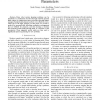Free Online Productivity Tools
i2Speak
i2Symbol
i2OCR
iTex2Img
iWeb2Print
iWeb2Shot
i2Type
iPdf2Split
iPdf2Merge
i2Bopomofo
i2Arabic
i2Style
i2Image
i2PDF
iLatex2Rtf
Sci2ools
123
Voted
RSS
2007
2007
Predicting Partial Paths from Planning Problem Parameters
— Many robot motion planning problems can be described as a combination of motion through relatively sparsely filled regions of configuration space and motion through tighter passages. Sample-based planners perform very effectively everywhere but in the tight passages. In this paper, we provide a method for parametrically describing workspace arrangements that are difficult for planners, and then learning a function that proposes partial paths through them as a function of the parameters. These suggested partial paths are then used to significantly speed up planning for new problems.
Related Content
| Added | 30 Oct 2010 |
| Updated | 30 Oct 2010 |
| Type | Conference |
| Year | 2007 |
| Where | RSS |
| Authors | Sarah Finney, Leslie Pack Kaelbling, Tomás Lozano-Pérez |
Comments (0)

